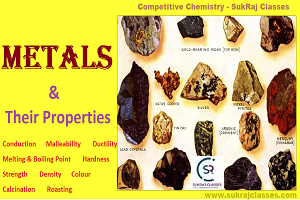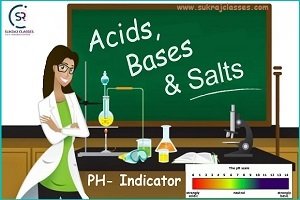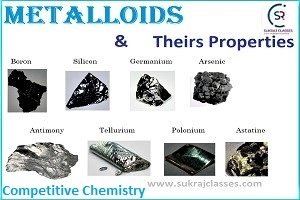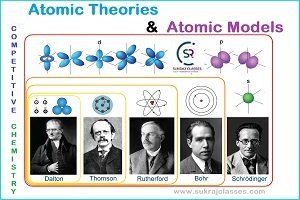
Metals and Their Properties – Characteristics of Metals
Chemistry topic- “Metals and Their Properties – Characteristics of Metals”, is important for all competitive exams like CET- Common eligibility Test, SSC CGL, SSC CHSL, RRB NTPC, UPSC and other state civil service exams. In these exams, almost 4-5 Questions are coming from Chemistry. Let’s start the topic:
Metals and Their Properties – Characteristics of Metals
An element is a substance that is made entirely from one type of atom.
All the materials found on the earth are composed of elements. All elements are classified in four categories:-
- Metals
- Non Metals
- Metalloids
- Noble Gases
Metals:-
Metals are the elements which form positive ions by losing electrons. Thus, metals are also known as the name of “Electropositive Elements”.
Metals are the elements that conduct heat and electricity and are malleable and ductile. Examples: – Iron (Fe), Aluminium (Al), Silver (Ag), Gold (Au).
Properties of Metals:-
Conduction: Metals are a good conductor of heat and electricity. This is the cause that electric wires are made of metals like Copper and Aluminium.
Malleability: Metals are malleable. This means metals can be beaten into a thin sheet. Because of this property, iron is used in making big ships.
Ductility: Metals are ductile. This means metals can be drawn into thin wire. Because of this property, a wire is made of metals.
Melting and Boiling Point: Metals have generally high melting and boiling points. (Except sodium and potassium metals which have low melting and boiling point.)
Hardness: Most of the metals are hard except to alkali metals, such as sodium, potassium, lithium, etc. are very soft metals. These can be cut by using a knife.
Strength: Most of the metals are strong and have high tensile strength. Because of this, big structures are made using metals, such as copper (Cu) and iron (Fe). (Except Sodium (Na) and potassium (K) which are soft metals).
Density: Most of the metals have a high density.
State: Metals are solid at room temperature except for mercury (Hg).
Sound: Metals produce ringing sound, so, metals are called Sonorous. Sound of metals is also known as Metallic sound. This is the cause that metal wires are used in making musical instruments.
Colour: Most of the metals are grey in colour, but gold and copper are exceptions.
Use of metals:
in Vehicles, electronic devices, farming instruments, household conveniences etc.
Occurrence of metals:-
- Metals occur in nature in free as well as combined form.
- The Earth’s crust is the major source of metals.
- Some metals are found in the earth’s crust in the free state such as gold, silver, mercury etc. and some are found in the form of their compounds form are known as minerals.
Important terms:-
Minerals: The natural substance in which metals occurs in the earth are called Minerals.
Ores: Ores are those minerals which contain metals. Example: Sulphide ore, Oxide ore, Carbonate ore.
-
- All ores are minerals, but not all minerals are ores.
Calcination: Calcination is a process in which ore is heated in the absence of air or air might be supplied in limited quantity.
-
- Calcination involves thermal decomposition of carbonate ores.
Roasting: Roasting involves heating of ore lower than its melting point in the presence of air or oxygen.
-
- Roasting is carried out mostly for sulphide ores.
Gangue: Ore mined from the earth’s crust contain a large number impurities or unwanted material like sand, rock, silicate etc. These impurities are called gangue or matrix.
Metallurgy: The process of extraction of metals from their respective metallic compounds is termed as metallurgy.
Corrosion: Corrosion is a process of deterioration or degradation of a metal due to reaction with air or water (environment) surrounding it.
- When metals are exposed to atmospheric conditions, they react with air or water in the environment to form undesirable compounds (usually oxides). This process is called corrosion.
- For example: copper develops a green coating, lead or stainless steel lose their lustre due to corrosion.
- In case of iron, corrosion is called rusting.
- Rusting of iron is generally caused by moisture, carbon dioxide and oxygen present in air. Chemically rust is hydrated form of ferric oxide.
Iron + oxygen → Iron (III) oxide
Fe + O 2 → Fe2O3
- Rusting of iron can be prevented by oiling, galvanizing, painting, greasing etc.
Galvanization: It is a method to protect steel and iron from rusting, a thin layer of zinc are coated on them, this is known as Galvanization.
For More:
If you like and think that General Science (Chemistry) topic on “Metals and Their Properties – Characteristics of Metals” was helpful for you, Please comment us. Your comments/suggestions would be greatly appreciated. Thank you to be here. Regards – Team SukRaj Classes.





